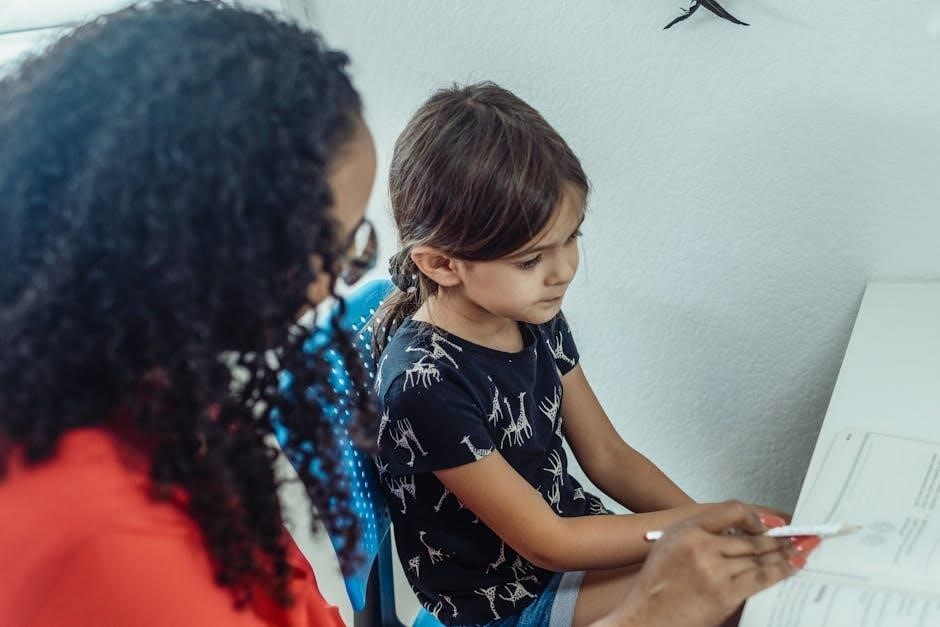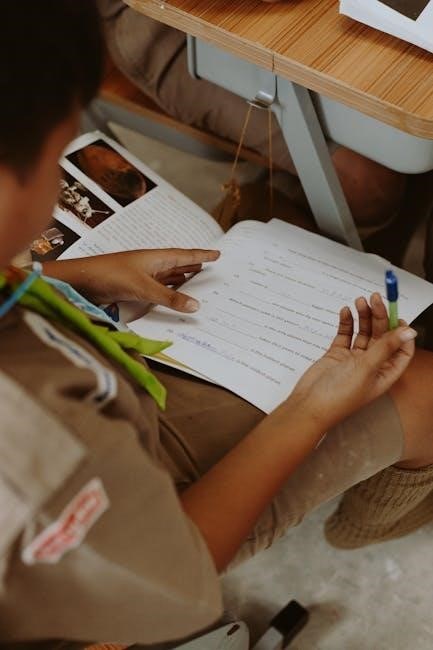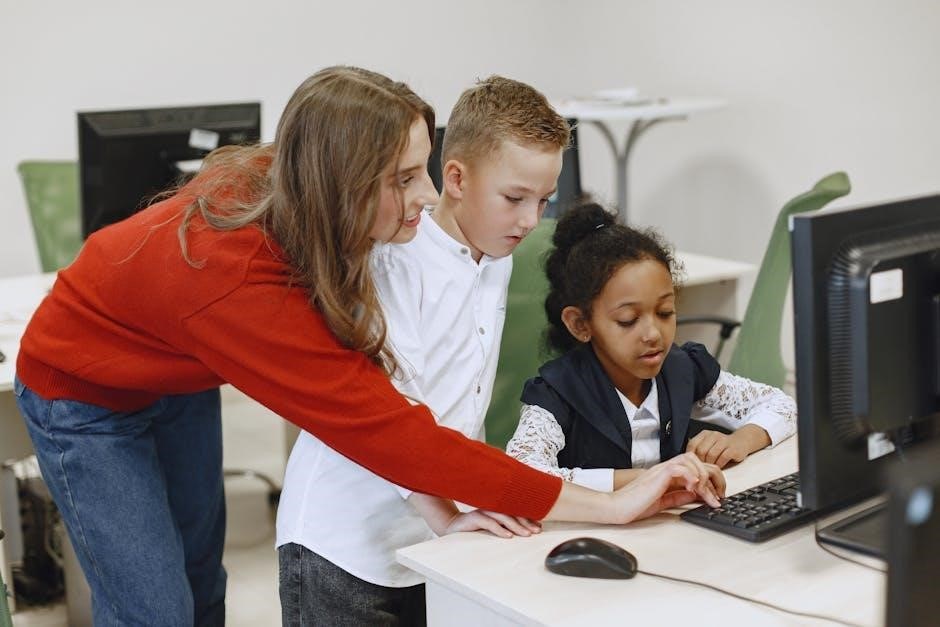teaching with multiple instructions helps learners to generalize because

Understanding Generalization in Learning
Generalization, a cornerstone of effective learning, involves applying learned skills across diverse contexts․ Teaching loosely and providing multiple examples are key strategies․ This ensures skills transfer beyond the classroom, promoting adaptability and real-world application of knowledge․

The Role of Multiple Instructions in Promoting Generalization
Multiple instructions play a crucial role in fostering generalization by exposing learners to varied approaches and perspectives․ When teachers use diverse language and presentation styles, students learn to adapt and transfer their knowledge to different situations․ This adaptability is essential for real-world application, where problems rarely present themselves in a uniform manner․
By encountering different instructions, learners develop cognitive flexibility, allowing them to process information from multiple angles․ This is particularly important in subjects requiring problem-solving, where innovative solutions often come from combining different strategies․ Multiple instructions also help students identify the core principles underlying a concept, rather than memorizing specific procedures․
Moreover, multiple instructions can address diverse learning styles․ Some students may benefit from visual aids, while others thrive on auditory explanations or hands-on activities․ By offering a variety of instructional methods, teachers can cater to individual needs and maximize learning outcomes․ This inclusive approach ensures that all students have the opportunity to grasp the material and apply it in various contexts, thus promoting effective generalization․

Defining Multiple Instructions in Teaching
Multiple instructions in teaching refer to the intentional use of varied methods, approaches, and examples to convey a single concept or skill․ This strategy goes beyond traditional, single-method teaching by incorporating diverse language, presentation styles, and learning activities․ The goal is to expose learners to different facets of the same subject matter, fostering a deeper and more adaptable understanding․
This approach can include using visual aids, auditory explanations, hands-on activities, and real-world examples․ It also involves presenting information in various formats, such as lectures, group discussions, and individual assignments․ By offering multiple pathways to understanding, teachers can cater to diverse learning styles and ensure that all students have the opportunity to grasp the material effectively․
Furthermore, multiple instructions encompass the use of different problem-solving strategies and perspectives․ Instead of teaching a single method for solving a problem, teachers encourage students to explore alternative approaches and develop their own unique solutions․ This not only enhances their problem-solving skills but also promotes critical thinking and creativity․ Ultimately, multiple instructions aim to equip learners with the ability to apply their knowledge in various contexts, fostering generalization and adaptability․

How Multiple Instructions Support Adaptability
Multiple instructions foster adaptability by exposing learners to varied approaches․ This promotes cognitive flexibility, enabling them to apply knowledge in novel situations; It enhances problem-solving skills and encourages creative thinking, crucial for real-world application․
Enhancing Cognitive Flexibility
Cognitive flexibility, a crucial skill, allows individuals to adapt their thinking and behavior to new, changing, or unexpected situations․ Multiple instructions play a vital role in enhancing this flexibility by exposing learners to diverse perspectives and problem-solving methods․ When students encounter varied instructions, they are compelled to think critically and adjust their approaches accordingly, preventing rigid thinking patterns․
This adaptability is essential for generalization, as real-world scenarios rarely mirror classroom conditions precisely․ By learning to navigate multiple instructions, students develop the capacity to transfer their knowledge and skills across different contexts effectively․ This prepares them to tackle unfamiliar challenges with confidence and creativity․
The use of varied language and presentation, as well as multiple examples, reinforces cognitive agility․ Learners trained with multiple instructions are better equipped to analyze situations, identify relevant information, and implement appropriate strategies․ This ultimately fosters a deeper understanding and facilitates successful generalization in various settings․
Strategies for Implementing Multiple Instructions Effectively
Effective implementation involves systematic variation in teaching methods․ Introduce diverse examples and create generalization plans․ Encourage critical thinking and real-world application․ This approach fosters adaptability, allowing learners to transfer skills across various environments, thereby promoting generalization․
Varying Language and Presentation
To enhance generalization, varying language and presentation is crucial․ Using different phrasing for instructions prevents students from becoming overly reliant on specific wording․ Incorporate diverse teaching styles, such as visual aids, auditory explanations, and kinesthetic activities, to cater to various learning preferences․ This ensures that students understand the underlying concepts rather than merely memorizing procedures․
Presenting information in multiple formats, like diagrams, charts, and real-world examples, further promotes adaptability․ Encourage students to rephrase instructions in their own words to demonstrate comprehension․ This active engagement reinforces understanding and facilitates transfer of knowledge to new situations․ Moreover, introducing variability in the learning environment, such as different settings or materials, prepares students for the unpredictability of real-world scenarios․
By encountering diverse stimuli and linguistic cues, students develop a deeper, more flexible understanding of the subject matter․ This adaptability is essential for successful generalization, enabling learners to apply their skills effectively in novel contexts․ Regular assessment, through generalization probes, validates the effectiveness of these strategies․
Varying language and presentation is a key element in promoting generalization and supports adaptability by enhancing cognitive flexibility․
Examples of Multiple Instructions in Different Subjects
Multiple instructions manifest differently across subjects, each promoting generalization in unique ways․ In mathematics, instead of rigidly adhering to one problem-solving method, students can be presented with various approaches to tackle the same equation․ This encourages adaptability and a deeper understanding of mathematical principles․
In language arts, instead of providing a single writing prompt, offer diverse prompts that require students to apply the same writing techniques in different contexts․ Encourage creative interpretations and varied writing styles to foster flexibility and critical thinking․ Similarly, in science, providing multiple experimental setups to investigate the same scientific concept allows students to see the underlying principles at play, regardless of specific materials or conditions․
For instance, teaching the concept of gravity can involve experiments with different objects, heights, and measuring tools․ In social studies, instead of simply memorizing historical facts, students can analyze events from multiple perspectives, using diverse sources and interpretations․ This promotes critical thinking and a nuanced understanding of history․ By employing multiple instructions across diverse subjects, students develop robust adaptability․ They enhance their ability to apply learned skills in various real-world scenarios․

The Link Between Multiple Instructions and Real-World Application
The strength of multiple instructions lies in bridging the gap between theoretical knowledge and real-world application․ By exposing learners to varied approaches and perspectives within a subject, we equip them to adapt their skills to unpredictable real-life scenarios․ When students encounter diverse problem-solving methods, they are better prepared to tackle novel situations that demand flexibility and innovation․
For example, in a business course, instead of solely focusing on textbook case studies, incorporating real-time simulations, guest lectures from industry professionals, and diverse team projects exposes students to the complexities of the business world․ This multi-faceted approach enhances their ability to apply learned principles in dynamic work environments․
Similarly, in healthcare education, simulated patient scenarios, diverse clinical rotations, and interdisciplinary team training provide a more holistic understanding of patient care than relying solely on textbook knowledge․ This prepares future healthcare professionals to navigate the complexities of patient needs and healthcare systems․ Ultimately, multiple instructions foster adaptability, critical thinking, and problem-solving skills that are essential for success in diverse real-world settings, empowering learners to transfer their knowledge effectively․
Assessing Generalization After Using Multiple Instructions
Evaluating generalization after employing multiple instructions requires moving beyond traditional tests․ Assessments should mirror real-world scenarios, challenging learners to apply knowledge flexibly․ Generalization probes, presenting novel examples of target skills, reveal true understanding․
Observe learners in various settings, noting their ability to adapt and transfer skills․ Portfolios showcasing diverse projects demonstrate skill application across contexts․ Encourage self-reflection, prompting learners to analyze their problem-solving approaches in different situations․
For example, after teaching math concepts through multiple methods, assess students’ ability to solve novel, real-world problems․ In language arts, evaluate if students can transfer writing skills to different genres and audiences․
Regular data collection is crucial in determining the effectiveness of generalization strategies․ This includes observing how learners perform previously learned skills․ By using varied assessments, we gain a comprehensive understanding of whether multiple instructions effectively promote generalization․ The goal is to ensure learners can confidently apply their knowledge in any setting, demonstrating true mastery․
Potential Challenges and Solutions
Implementing multiple instructions to promote generalization presents several challenges․ Learners might experience initial confusion due to varied approaches․ Time constraints can hinder the development and execution of diverse teaching strategies․ Resistance from educators accustomed to traditional methods may also arise․
Solutions involve careful planning and gradual implementation․ Start by introducing variations incrementally, ensuring learners grasp fundamental concepts first․ Provide ample support and scaffolding, allowing learners to adjust to different instructional styles․ Offer professional development opportunities for educators, showcasing the benefits of multiple instructions․
Address learner confusion through clear communication and consistent feedback․ Create a supportive learning environment where experimentation is encouraged․ Overcome time constraints by integrating multiple instructions into existing lesson plans, rather than creating entirely new activities․
Foster collaboration among educators to share resources and best practices․ Highlight successful generalization examples to demonstrate the effectiveness of this approach․ By proactively addressing these challenges, we can maximize the benefits of multiple instructions and promote lasting generalization in learning․